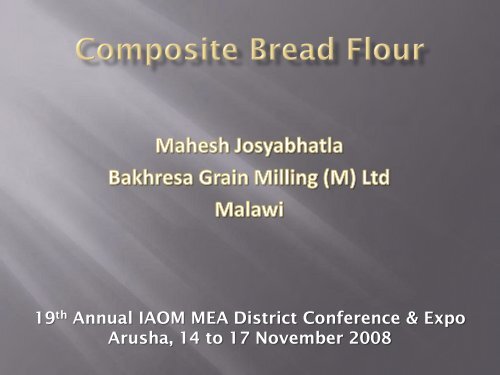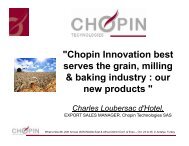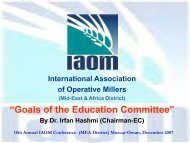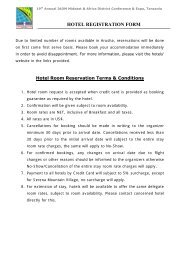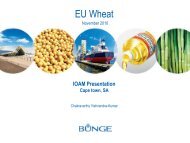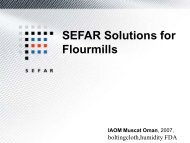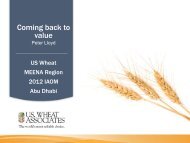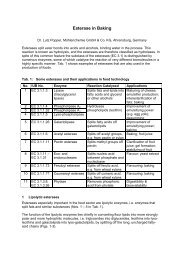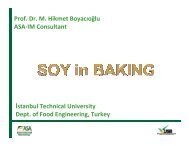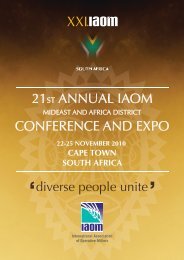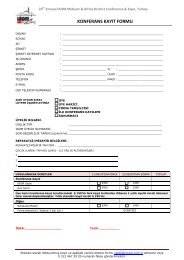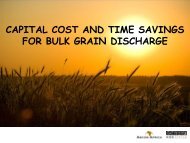Session IV – Composite Bread Flour - Bakhresa Grain Milling
Session IV – Composite Bread Flour - Bakhresa Grain Milling
Session IV – Composite Bread Flour - Bakhresa Grain Milling
Create successful ePaper yourself
Turn your PDF publications into a flip-book with our unique Google optimized e-Paper software.
19 th Annual IAOM MEA District Conference & Expo<br />
Arusha, 14 to 17 November 2008
A flour made by blending varying<br />
amounts of non-wheat flour with or<br />
without wheat flour and used for<br />
the production of leavened bread<br />
and other baked products that are<br />
traditionally made from wheat flour
• To reduce cost of end products<br />
• To save valuable foreign exchange<br />
• To promote indigenous crops<br />
• To develop local agribusiness<br />
• To enhance nutritional value<br />
• To produce breads for gluten intolerant
• Initially it was introduced as an emergency measure in the<br />
developed countries during the two world wars when<br />
wheat supplies were limited<br />
• In 1964, FAO established the <strong>Composite</strong> <strong>Flour</strong> Programme<br />
to identify those non-wheat materials that could be used in<br />
developing countries to extend wheat flour for bread<br />
making<br />
• In 1970’s at the instigation of FAO, several tests were<br />
conducted at what was then the TNO Institute for cereals,<br />
<strong>Flour</strong> and <strong>Bread</strong> in Wageningen, Netherlands and at<br />
Tropical Products Institute in London and at Kansas State<br />
University, Manhattan, USA.
• Joint projects were carried out by the FAO and UNDP<br />
in Brazil, Peru, Nigeria and Senegal to examine<br />
possibility of using home-grown in conjunction with<br />
wheat flour.<br />
• Several countries viz India, Peru, Ghana, Nigeria, West<br />
Indies and Philippines took the initiative themselves<br />
and started to develop ways of using local products<br />
• International Association for Cereal Science and<br />
Technology (ICC) in Vienna set up a study group that<br />
promoted the investigation and use of composite<br />
flours by organising symposia, seminars and<br />
discussion meetings and through numerous<br />
publications in specialist periodicals.
• Lack of commercial approach<br />
• Too academic and research oriented<br />
• Insignificant involvement of key stake<br />
holders<br />
• Lack of efforts to market the concept<br />
and/or technology
• <strong>Milling</strong> of wheat into flour<br />
• Gluten<br />
• Extraction<br />
• Processing of non-wheat flour<br />
• Suitability for end use<br />
• Cost at point of use<br />
• Availability<br />
• Consistency<br />
• Blending<br />
• Additives/Improvers
• Methods of making <strong>Bread</strong><br />
• Traditional Vs MDD<br />
• Key Differences<br />
• Water absorption<br />
• Yeast<br />
• Dough development<br />
• Fermentation and Proofing<br />
• Baking time & temperature
WF<br />
CF<br />
CF
• Appearance<br />
• Volume<br />
• Shape<br />
• Crust colour<br />
• Aroma<br />
• Crumb<br />
• Colour<br />
• Texture<br />
• Taste


